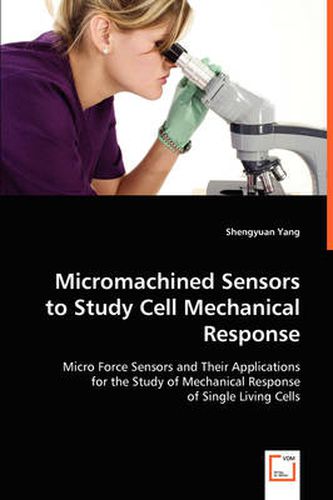Readings Newsletter
Become a Readings Member to make your shopping experience even easier.
Sign in or sign up for free!
You’re not far away from qualifying for FREE standard shipping within Australia
You’ve qualified for FREE standard shipping within Australia
The cart is loading…






This title is printed to order. This book may have been self-published. If so, we cannot guarantee the quality of the content. In the main most books will have gone through the editing process however some may not. We therefore suggest that you be aware of this before ordering this book. If in doubt check either the author or publisher’s details as we are unable to accept any returns unless they are faulty. Please contact us if you have any questions.
Increasing evidence has shown that living cells respond to mechanical stimuli not only mechanically but also biochemically. But how they respond to mechanical stimuli and the mechanisms through which they transduce the mechanical stimuli into biological responses re-main largely unclear. In this research, novel versatile and flexible microelectromechanical systems (MEMS) sensors were developed for studying mechanical response of single living cells. These sensors measure cell force res-ponse in the range of one nano newton to one micro newton, which is largely inaccessible for the current relevant prevalent techniques such as atomic force microscopy, optical tweezers, and magnetic twisting cytometry. These sensors have been used to study the mechanobiological response of fibroblasts, endothelial cells, and neu-rons, and first-time experiments and surprising findings are reported. This work enhances our current understanding and sheds new light on cellular mechanosensitivity and mechanotransduction. This book, therefore, is especially useful for researchers and engineers related to cell and tissue mechanobiology, MEMS, tissue engineering, and regenerative medicine.
$9.00 standard shipping within Australia
FREE standard shipping within Australia for orders over $100.00
Express & International shipping calculated at checkout
This title is printed to order. This book may have been self-published. If so, we cannot guarantee the quality of the content. In the main most books will have gone through the editing process however some may not. We therefore suggest that you be aware of this before ordering this book. If in doubt check either the author or publisher’s details as we are unable to accept any returns unless they are faulty. Please contact us if you have any questions.
Increasing evidence has shown that living cells respond to mechanical stimuli not only mechanically but also biochemically. But how they respond to mechanical stimuli and the mechanisms through which they transduce the mechanical stimuli into biological responses re-main largely unclear. In this research, novel versatile and flexible microelectromechanical systems (MEMS) sensors were developed for studying mechanical response of single living cells. These sensors measure cell force res-ponse in the range of one nano newton to one micro newton, which is largely inaccessible for the current relevant prevalent techniques such as atomic force microscopy, optical tweezers, and magnetic twisting cytometry. These sensors have been used to study the mechanobiological response of fibroblasts, endothelial cells, and neu-rons, and first-time experiments and surprising findings are reported. This work enhances our current understanding and sheds new light on cellular mechanosensitivity and mechanotransduction. This book, therefore, is especially useful for researchers and engineers related to cell and tissue mechanobiology, MEMS, tissue engineering, and regenerative medicine.